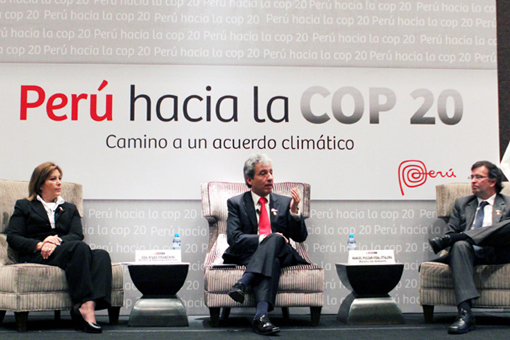As host of the upcoming United Nations Climate Change Conference in December, Peru has assumed a challenging burden. Ministers and high representatives of 195 countries and international organizations, along with roughly 15,000 visitors, will gather in Lima to mark the 20th annual session of the Conference of the Parties (known as COP 20)—the governing body of the international convention. The work plan is as challenging as the conference logistics: delegates are expected to draft a document that will serve as the basis of a multinational agreement on reducing global warming, to be signed in Paris in 2015.
The odds of reaching such consensus seem slim. The richest countries of the world are just coming out of an economic crisis (some are still struggling), and emerging economies such as China and Brazil have experienced slowed economic growth. Developing countries such as China and India refuse to shoulder the burden of reducing carbon emissions if that implies curtailing economic development, while developed countries show an increased reluctance to adopt global climate change agreements. Japan, for example, has opted out of prior commitments to reduce emissions to specific target levels, while the Australian Parliament just repealed a carbon tax this summer established under the previous administration.
Unfortunately, even Peru’s commitment to environmental safeguards seems to have weakened ahead of the summit—calling into question its ability to set an effective example as summit host.
As in other developing nations, Peru’s environmental backsliding has economic roots. The country faces a significant decline in the price of its main export commodities—mostly metals and minerals—and a sharp drop in GDP growth.
As a result, it is hoping to jump-start its economy by attracting greater levels of domestic and foreign investment. The recovery plan, however, appears to involve a sharp reduction in environmental safeguards.
The first indication came with the June 2014 announcement by Peruvian President Ollanta Humala of a number of economic measures that include new incentives for investment in the mining and energy sectors. The measures have opened him to charges that he is putting the economy ahead of the environment.
Specifically, the plan calls for a temporary 35 percent reduction in fines for environmental violations. Since this law places the emphasis on corrective actions rather than preventive measures, environmentalists fear that the worst sanction a company could get for failing to apply clean technology or for contaminating a river is to be ordered to restore the situation to its previous state. Since lower fines are cheaper than making preventive investment upfront, the risk is that companies will just build them into their annual budgets as expenses without making any real effort to avoid environmental damage.
Necessary Tradeoffs?
Many in the private sector argue that ensuring economic growth and greater investment is Peru’s top priority. As Peruvian economist Gianfranco Castagnola wrote in his column in Perú21.pe in July, these measures are needed to speed up the permit approval process in the mining, electricity and hydrocarbons sectors. Under the new measures, permit applications will have to be decided upon in 45 days, as opposed to the previous system, which could take up to two years.
Moreover, Peru produces only 0.4 percent of global gas emissions, mostly from land use, not from fossil fuels. Even if Peru’s emissions doubled, the impact on global climate would be negligible.
More alarming, however, is Peru’s vulnerability to climate change. Peru is home to four of the five geographical areas most vulnerable to climate change—from fragile mountain ecosystems to low-lying coastal areas. Some environmentalists argue, therefore, that Peru could use its role as summit host to showcase efforts to put climate adaptation at the head of the world’s environmental agenda.
Hector Maletta, who studies adaptation opportunities in agriculture in the Andean region at the Centro de Investigación de la Universidad del Pacífico (CIUP), says that Peru’s varied ecology enables farmers to take advantage of some changes in climate, such as the increased rainfall and temperatures in Peru’s highlands—especially at altitudes above 10,000 feet (3,000 meters), where arid soil and cold temperatures are major constraints on agriculture. Maletta suggests that because rainfall occurs predominately in the summer, followed by a dry winter, the government should prioritize the construction of reservoirs that can regulate the flow of water, thereby avoiding landslides and floods while improving conditions for irrigated agriculture.
Peru once appeared to be heading in the right direction. In 2008, the government announced it would contribute to global climate change mitigation efforts by conserving 54 million hectares of forest (42 percent of the national territory) by 2021 to reverse the process of illegal logging and burning and to substantially reduce deforestation. As a consequence, the National Forest Conservation Program for Mitigation Against Climate Change was created in 2010 to reach this goal. Currently, around 17 percent of the national territory has been protected.
But will the country’s economic problems allow it to complete the job? One potential source of funding is the REDD+ (Reducing Emissions from Deforestation and Degradation) initiative led by the World Bank. The initiative, which is aimed at strengthening forest governance at a local and national level, empowers Indigenous communities who live in the forest to manage it in a sustainable way. There are already many projects under way in Peru, with the funding paying for regional monitoring and reporting systems that can generate reliable digital data to enable researchers to determine direct and indirect causes of deforestation and forest degradation.
Peru’s moment in the spotlight of the global climate change debate may have come at a controversial time. While the country’s current plight underscores the challenge many nations are facing as they try to address economic slowdowns, Peru also has an opportunity to demonstrate that the narrow pursuit of economic development carries real and immediate environmental and economic costs of climate change that no country can afford.





